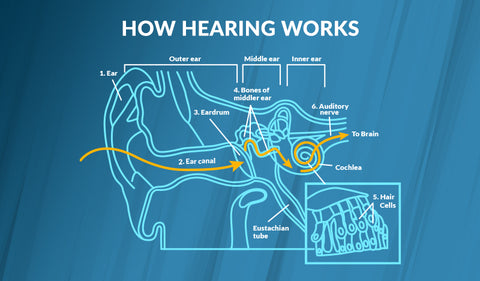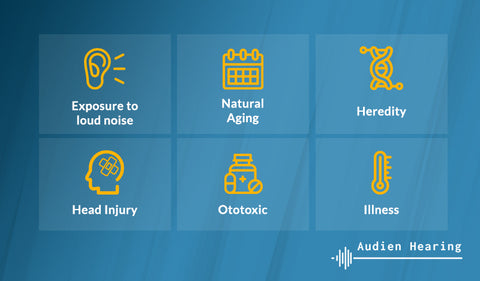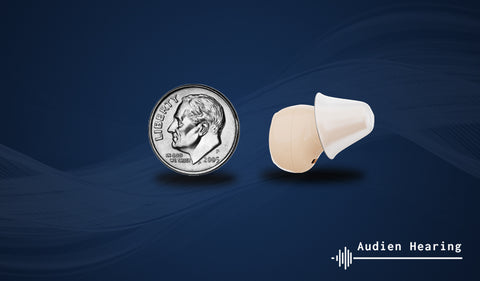Welcome to your complete guide on hearing loss! If you think you or a loved one may have hearing loss and are looking for some more information on the subject, you’ve come to the right place. We've put together a comprehensive resource on hearing loss, covering everything we could, including signs, types, causes, symptoms, treatments, and more. Read on to learn everything there is to know about hearing loss!
Hearing Loss Guide
Since there's so much to cover when it comes to hearing loss, we’ve tried to make it easy for you to find what you’re looking for. Click any of the links below to skip to any section of the resource:
- What is Hearing Loss?
- Signs of Hearing Loss
- Getting Your Hearing Tested
- Types of Hearing Loss
- Degrees of Hearing Loss
- Causes of Hearing Loss
- Symptoms of Hearing Loss
- Treatments for Hearing Loss
What is Hearing Loss?

Hearing loss is defined as a partial or total inability to hear. According to the World Health Organization, people with hearing loss are unable to hear as well as people with normal hearing, which is typically a threshold of around 25dB.
Hearing loss occurs over a spectrum of different frequencies (250-8000Hz). The level of hearing loss is reflected by decibels (dB).
The wider the frequency of hearing loss, the harder it is to hear sounds at different pitches. The higher the level of hearing loss, the higher your threshold of decibels to hear will be.
Signs of Hearing Loss

Before you notice specific symptoms, you may notice signs of hearing loss in everyday life, such as:
- Turning up the volume on the TV
- Trouble hearing in restaurants
- Frequently asking people to repeat themselves
- Difficulty hearing children’s voices
- Reading lips instead of listening
- Your ears feel muddled or clogged
- Exhaustion after social gatherings or conversation
Getting Your Hearing Tested

If you notice that you are experiencing one or more of the early signs of hearing loss, you may want to look into taking a hearing test. There are simple online hearing tests available that can quickly and easily give you an audiogram, which maps out your level of hearing loss across the spectrum of different frequencies.
More advanced hearing tests can also be given at a hearing center by an audiologist. Generally, if you are getting tested at a hearing center, they may offer you solutions to your hearing problems.
We recommend everyone get their hearing tested to get a better understanding of their hearing loss. If your hearing test indicates severe to profound hearing loss, you may want to consider a more advanced hearing solution. If your audiogram indicates mild to moderately severe hearing loss, you may be able to consider a much more affordable solution.
Types of Hearing Loss

There are several different types of hearing loss. We will cover these types based on the spectrum of frequencies that someone can or cannot hear. We will also break down the types of hearing loss based on their different underlying causes.
High Frequency Hearing Loss

High frequency hearing loss occurs when you are unable to hear sounds on the higher end of the frequency spectrum. This means you may have difficulty hearing higher pitched sounds such as children’s voices, a telephone, birds or animals, or even the wind.
High frequency hearing loss has a variety of different causes, with aging and noise exposure being the most common; genetics, disease and medications can also be a factor.
To treat high frequency hearing loss, you just need to find a hearing aid that works on a broad range of frequencies. There are more expensive options with advanced feedback reduction capabilities, and for those working on a budget, basic hearing devices that work on the full spectrum are suitable.
To learn more, read our full article about high frequency hearing loss.
Low Frequency Hearing Loss

Low frequency hearing loss occurs when you are unable to hear deeper or lower pitched sounds on the frequency spectrum. This means you may have difficulty hearing sounds such as:
- deep bass effects in movies or TV
- the sound of thunder
- vehicles
- vowel sounds in conversations (which are usually delivered at a lower frequency)
Low frequency hearing loss is often caused by Meniere’s Disease, a condition that occurs due to fluid buildup in the ear canal. It can also be caused by aging and a number of other factors.
For certain reversible types of low frequency hearing loss, surgery can be an effective treatment. Another suitable treatment is hearing aids that are programmed to amplify sounds over a lower spectrum of frequencies. For example, Audien Hearing’s EV1 Hearing Aids work over a spectrum of 300-4500Hz, suitable for low frequency hearing loss. For those seeking more customization, they can get hearing aids programmed specifically based on their frequency of hearing loss, but they are significantly more expensive nd require the diagnosis of an audiologist. Find what works best for you and your situation!
To learn more, read our full article about low frequency hearing loss.
Conductive Hearing Loss

Conductive hearing loss occurs due to problems with the ear canal, ear drum, or middle ear. Conductive hearing loss means the sound is unable to reach the inner ear, usually due to an obstruction or damage.
Some causes of conductive hearing loss include:
- fluid in the ear
- malformation of the ear canal
- wax buildup
- allergies and more.
Treatment of conductive hearing loss varies depending on severity. For some, surgery is a suitable option; for others, hearing aids can be a solution.
To learn more, read our full article about high frequency hearing loss.
Sensorineural Hearing Loss

Sensorineural hearing loss is hearing loss caused by damage to the inner ear. It is also known as nerve-related hearing loss. This type of hearing loss is permanent.
Normally, the cause of sensorineural hearing loss is exposure to loud noises, but it can also be caused by:
- aging
- virus
- disease
- otosclerosis and more.
Sensorineural hearing loss treatments vary based on the type of hearing loss. Treatments may include surgery, corticosteroids, cochlear implants, or the use of hearing aids.
For more, read our full article about sensorineural hearing loss.
Mixed Hearing Loss

Mixed hearing loss is a combination of conductive hearing loss and sensorineural hearing loss. This implies both a problem with your middle ear and your inner ear nerves.
Mixed hearing loss is caused by the same things that cause sensorineural and conductive hearing loss. For example, someone may have mixed hearing loss in the following circumstances:
- after being exposed to loud noises
- damaging the inner ear nerves
- having fluid buildup
- obstructing the middle ear canal
Mixed hearing loss is treated similarly to conductive and sensorineural hearing loss.
For more, read our full article on mixed hearing loss.
Degrees of Hearing Loss

As you can probably tell by now, hearing loss comes in many different shapes, sizes, forms and degrees. Your degree of hearing loss is generally measured by the threshold at which you can hear sounds.
People with normal hearing can hear sounds ranging from -10 to 15 dB. The decibel ranges for each degree of hearing loss are as follows:
- Mild hearing loss: 26-40 dB
- Moderate hearing loss: 41-55 dB
- Moderately severe hearing loss: 56-70 dB
- Severe hearing loss: 71-90 dB
- Profound hearing loss: 91+ dB
For more information, read our full article on the degrees of hearing loss (make a resource like this we can have in the article, a cool table).
Causes of Hearing Loss

The causes of hearing loss vary widely based on the type of hearing loss and other factors. In general, here are some of the most common causes of hearing loss:
- Noise Exposure (often associated with inner ear damage)
- Aging
- Virus or Disease
- Genetics
- Tumors
- Smoking
For a more in depth look at these causes, check out our full article on the causes of hearing loss.
Symptoms of Hearing Loss

Symptoms of hearing loss may include:
- muffled sound and speech
- difficulty hearing higher pitched sounds
- trouble hearing the TV
- asking people to repeat themselves or speak up
- generally feeling left out of the conversation
Hearing loss is a serious issue with serious ramifications. It can have a strong detrimental impact on your social, emotional, and mental wellbeing. In fact, recent research has connected hearing loss to an increased chance of Alzheimer’s, dementia and depression.
If you’re experiencing any of the symptoms of hearing loss, we recommend you get a hearing test. Simple online tests can also diagnose your level of hearing loss.
Treatments for Hearing Loss

Treatments for hearing loss can include:
- surgery
- cochlear implant
- corticosteroids
- hearing aids
- assistive listening devices and more
Most cases of hearing loss can be treated with hearing aids or assistive listening devices. For more severe or rare cases, surgery or other medical intervention may be necessary. This is why it's important to get a diagnosis from an audiologist so you can find the proper form of treatment for your specific needs.
As discussed above, the treatments for hearing loss vary based on the type of hearing loss. For more severe cases of hearing loss, getting a custom programmed digital hearing aid may be necessary; while the cost is high, these types of devices are best suited for severe to profound hearing loss.
For those with mild to moderately severe hearing loss, lower end hearing aids or personal sound amplifying products (PSAPs) may be a viable option. Unfortunately, most Americans cannot afford hearing aids at their higher ticket price point, so at Audien Hearing our goal is to make hearing aids more accessible.
Concluding Thoughts From Audien Hearing














